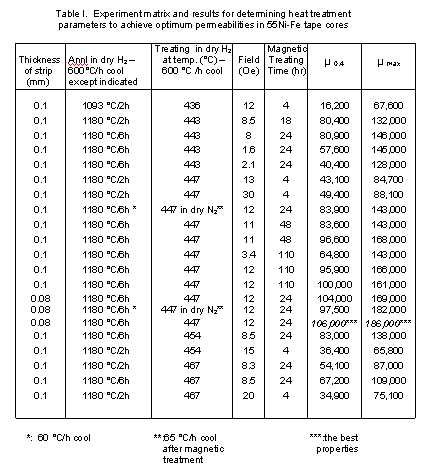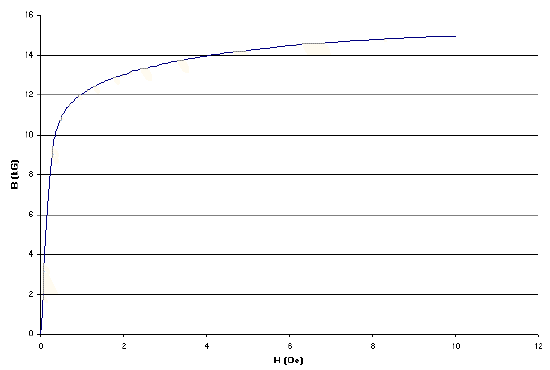Controlling Annealing and Magnetic Treatment Parameters
White Papers
Abstract
The 55Ni-Fe alloy is a soft magnetic material capable of combining high permeability (e.g. 0.4>100,000 and max >180,000 in 0.08 mm strip measured at 60Hz) and high saturation induction (1.5 T) compared to 78~80Ni-Fe and 48~50Ni-Fe alloys, after a proper thermal-magnetic treatment. The permeabilities of 55Ni-Fe tape cores are very sensitive to annealing temperature and time, magnetic treatment temperature and time, as well as field direction and strength during the treatment. This paper summarizes these effects. The optimum treatments determined are: secondary recrystallization annealing at 1180 ºC for 6 hrs in dry H2, followed by 24-hr uniaxial magnetic ordering treatment at 447 ºC in dry H2 (or in dry N2) with a circumferential DC field (>10-12 Oe) applied during treatment and cooling. The cooling rates after annealing or treatment are less critical and can be 50-650 ºC/h as long as the field during treatment is higher than 10-12 Oe.
This article has been published in "IEEE Transaction on Magnetics. Vol 37. No.4 (July 2001) pp 2315-2317,"
Introduction
Alloys of 77~80Ni-Fe (HyMu "77"TM plus alloy, CarTech HyMu "80"® alloy) are well known for their excellent permeabilities. These alloys are capable to reach 0.4=250,000~300,000 (initial permeability at 0.4 A/M) and max= 400,000~470,000, both were measured at 60Hz on 0.07 mm strip, with the saturation induction Bs =7.4 kG [1-2]. Lower nickel alloys such as 48~50Ni-Fe (CarTech High Permeability "49"® alloy) are also widely used because of lower material costs while demonstrating high Bs (16 kG) and good permeabilities (e.g. 0.4=~17,000; max=~80,000 at 60Hz measured on 0.15 mm strip) [3] .
While less known, 55Ni-Fe (Carpenter High Permeability "55") alloy has a combination of high Bs (15 kG) and high permeability (e.g. 0.4>100,000, max >180,000 at 60Hz measured on 0.08 mm strip) after a magnetic uniaxial ordering treatment below Curie temperature. Due to its particular magnetic properties and cost effectiveness (low nickel content, high Bs and high , so less core weight needed for required signal output), 55Ni-Fe alloy has been used in some niche applications such as LF transducers, integrating current transformers for earth-leakage circuit breakers, and high metering accuracy (HMA) cores[4].
However, it is critical to heat treat 55Ni-Fe properly in order to get the best permeabilities. Previous papers [5-7] had shown that magnetictreatment can increase permeability in 50~65Ni-Fe significantly. However, there has been a lack of details on how to heat treat the commercial 55Ni-Fe alloy to manufacture high quality cores in a production environment. This paper demonstrates the sensitivities of various heat treatment parameters, and provides potential users with the optimum parameters to fully utilize the advantages of this alloy.
Experiment
The alloy was made in a 7-ton vacuum induction furnace. The ingots were then forged, hot-rolled and cold-rolled to obtain 0.08-0.1 mm strip. Melting and processes must be carefully controlled to consistently produce the High Permeability "55" alloy exhibiting the high quality shown in Table I, after heat treatments with recommended optimum parameters. All the properties reported in this paper are from a single heat.

Tape cores with ID=1.25", OD=1.5", height = 0.5" were tested for magnetic capability impedance permeability, via sine H, 60 Hz test method that is normally used in the USA. The max on the same core will be noticeably higher (e.g.: max >202,000) than that reported in this paper if measured using the sine B, 50Hz test method currently used in the Europe.
The cores were first annealed in dry H2 at 1180 °C for 2 to 6 hours, then cooled at 60 to 600 °C/hr. The cores must show a shiny and bright surface after annealing to achieve top properties. The cores then undergo a thermal magnetic treatment at around 447 ºC in dry H2 (or dry N2) for 4 to 110 hrs. We used the following technique to generate a DC field during magnetic treatment: high temperature tape was used to wrap the annealed cores for insulation, then Cu wire protected with a fiber glass sleeve was wound over the insulation. A DC current through the winding then generates a circumferential field on the core. The field was applied during the entire magnetic treatment and cooling duration.
A straight Cu bar carrying a large current and passing through the axis of many cores can generate circumferential DC field in a mass production environment. It is necessary to locate the current bar at the center of the cores and not contact with inside diameter. Otherwise, the DC field is highly distorted resulting in decreased permeability after magnetic treatment. Another way to generate field is to loop the Cu bar to form a one-turn coil on the cores. In both cases, the circumferential field strength can be easily determined according to the core size and the current intensity.
Results and Discussions
1. Annealing temperature and time, cooling rate effects
The annealing temperature should be about 1180-1200 ºC in dry hydrogen, in order to effectively eliminate dislocations, promote grain growth and achieve secondary recrystallization. One example shows that the tape core annealed at 1093 ºC has much lower permeability (see data listed in Table I) compared with that of cores annealed at 1180 ºC with other heat treatment parameters being similar.
A six-hour hydrogen anneal resulted in higher permeability than a two-hour anneal. The longer time at annealing temperature in dry H2 reduces carbon and sulfur to less than 30 ppm in the cores. It also permits full development of the secondary recrystallization texture.
The faster cooling (>600 ºC/h) after annealing resulted in higher :0.4 =10,000 in contrast to :0.4=1,500 after slower cool (e.g. 80 ºC/hr). Nevertheless, we have found that final permeabilities do not depend on the cooling-rate after the 1180 ºC annealing, as long as the magnetic field is strong enough (>10-12 Oe) to keep the cores at saturation during the magnetic treatment (see item b in next section).
2. Magnetic treatment temperature, time, and field strength effects
Due to its higher Ni content, 55Ni-Fe has higher Curie temperature (about 530 ºC) than that of 48~50Ni-Fe alloys (about 450 ºC). Therefore, thermomagnetic treatment is kinetically feasible to be done at a relatively high temperature (440-450 ºC) to create induced anisotropy within an acceptable time period ( e.g. 24 hrs), resulting in much higher permeability along the induced easy axis. Table I shows results from the experimental matrix for determining optimum heat treatment parameters. The following conclusions are drawn from the table:
a). There is an optimum magnetic treatment temperature: Treating at lower (<430 ºC) or higher (>467 ºC) temperatures will not achieve the best permeabilities. Both anisotropy and magnetostriction along the directional ordering axis depend on temperature and structure. The superstructures formed at various treatment temperatures are slightly different. Therefore an optimum treatment temperature (determined as 447 ºC) exists to minimize the anisotropy and/or magnetostriction along the ordering direction at room temperature. A more direct explanation is: at higher temperature closer to Curie point, increased thermo-vibration leads to a less aligned structure; at lower temperature, the rate of short-range-diffusion is lower, therefore less aligned structure is formed at a given time period.
b). A minimum magnetic field is required during treatment and cooling for reaching best permeability: If the field is too low (e.g. < 3 Oe), the permeabilities after treatment are significantly lower than the optimum values. The field should be strong enough to align all spins completely to form a new circumferential easy axis after treatment, regardless of the orientation of the original crystalline easy axis. The experiments have determined that a field of 10-12 Oe is minimum. Figure 1 shows the room temperature magnetization curve of an annealed 55Ni-Fe core after fast cooling but before magnetic treatment. It clearly demonstrates that a field of 10-12 Oe field is necessary to reach full alignment. (This seems to be true at 447ºC also, according to treatment results). In a production environment, cores are usually cooled slowly after annealing; the initial permeability therefore is low before magnetic treatment. However, the final permeability is still high as long as the cores reach saturation-induction during the short range ordering treatment. This is confirmed by the results in Table I. Fields higher than 10-12 Oe bring no improvement.
If the production facility is not capable of generating a 10-12 Oe field (because of limited current or larger core sizes), a faster cool after 1180 ºC annealing will be helpful to enhance the final permeability, although the permeability will not reach the optimum value. The faster-cooled cores can reach higher induction at a lower field during magnetic treatment.

Fig. 1 - The room temperature magnetization curve of a 55 Ni-Fe core after 1180 oC/6h - cool at 600 oC/h, before magnetic treatment.
c. The longer the magnetic treatment time, the higher the permeability: 4-hr treatment results in only 40-50% of achievable properties. The treating time of 18-hrs and 24-hrs are needed to reach to about 80% and 90% of optimum permeability, respectively. Over 24-hr treatment, the rate of permeability increase is much slower. We therefore recommend that 24-hr treatment is economically sound, considering alloy performance vs process cost.
d. Thinner strip for higher permeability: 0.08 mm strip demonstrated about 20% higher permeability than 0.1 mm strip. This obviously is because of lower eddy current loss incurred in thinner strip. Since little difference exists in handling these two types of strips during tape core production, we choose 0.08 mm strip as the standard product.
e. Cooling after treatment: the cooling rate is not critical. However, the magnetic field is required during the cooling to room temperature.
Conclusions
An alloy of 55Ni-Fe, combining high permeability and high saturation induction, is a cost effective soft magnetic alloy for certain applications. However, a tape core of this composition will only show top quality after a well-controlled heat treatment. We have determined optimum heat treatment parameters as: annealing at 1180ºC for 6 hrs in dry H2, followed by 24-hr magnetic treatment at 447 ºC in dry H2 (or in dry N2) with a circumferential DC field (>10-12 Oe) applied during treatment and cooling. The cooling rates after annealing or treatment are less critical and can be 50-650ºC/h, as long as the field during treatment and cooling is higher than 10-12 Oe.
References:
Registered trademark of CRS Holdings, Inc., a subsidiary of Carpenter Technology Corporation.
[1] Carpenter Technology Corporation: Data sheet for Permalloy alloys
[2] Lin Li and M. S. Masteller: "Effects of Mo content and baking temperature on permeability in Ni-Mo-Cu-Fe and Ni-Mo-Fe Permalloys" IEEE Trans on Mag. Vol. 33 No. 5 (Sept. 1997) pp3769-3771
[3] Carpenter Technology Corporation: Data sheet for "High Permeability 49" alloy
[4] Alloy data for 55Ni-Fe alloy: Alloy Digest, published by ASM International, Filing Code Ni-514
[5] Gunther Rassmann und Harry Wich: "Wekstoffzustand und magnetische Eigenschaften der Legierung mit 50%Ni und 50%Fe" Berichte AG Ferromagnetismus, 181 (1959)
[6] I.K. Kang, H.H. Scholefield, and A.P. Matin: "Some concepts concerning the new high permeability 50-50 nickel-iron alloys" J. Appl. Phys. Vol 38, No.3 (March, 1967) pp1178-1183
[7] F. Pfeifer and C. Radeloff: "Soft magnetic Ni-Fe and Co-Fe alloys-some physical and metallurgical aspects" J. Magnetism and Magnetic Materials, 19 (1980) PP190-207
***
By Lin Li
Carpenter Technology Corporation
Reading, PA